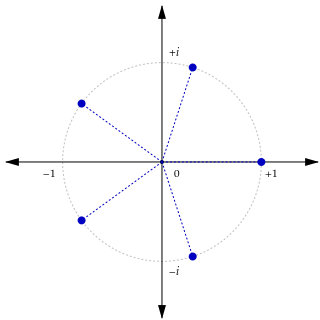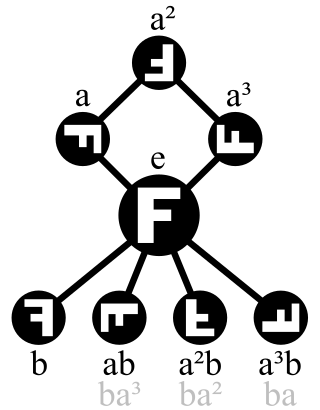
In mathematics, a monogenic semigroup is a semigroup generated by a single element. [1] Monogenic semigroups are also called cyclic semigroups. [2]

In mathematics, a monogenic semigroup is a semigroup generated by a single element. [1] Monogenic semigroups are also called cyclic semigroups. [2]
The monogenic semigroup generated by the singleton set {a} is denoted by . The set of elements of is {a, a2, a3, ...}. There are two possibilities for the monogenic semigroup :
In the former case is isomorphic to the semigroup ({1, 2, ...}, +) of natural numbers under addition. In such a case, is an infinite monogenic semigroup and the element a is said to have infinite order. It is sometimes called the free monogenic semigroup because it is also a free semigroup with one generator.
In the latter case let m be the smallest positive integer such that am = ax for some positive integer x ≠ m, and let r be smallest positive integer such that am = am+r. The positive integer m is referred to as the index and the positive integer r as the period of the monogenic semigroup . The order of a is defined as m+r−1. The period and the index satisfy the following properties:
The pair (m, r) of positive integers determine the structure of monogenic semigroups. For every pair (m, r) of positive integers, there exists a monogenic semigroup having index m and period r. The monogenic semigroup having index m and period r is denoted by M(m, r). The monogenic semigroup M(1, r) is the cyclic group of order r.
The results in this section actually hold for any element a of an arbitrary semigroup and the monogenic subsemigroup it generates.
A related notion is that of periodic semigroup (also called torsion semigroup), in which every element has finite order (or, equivalently, in which every monogenic subsemigroup is finite). A more general class is that of quasi-periodic semigroups (aka group-bound semigroups or epigroups) in which every element of the semigroup has a power that lies in a subgroup. [5] [6]
An aperiodic semigroup is one in which every monogenic subsemigroup has a period of 1.

In mathematics, an abelian group, also called a commutative group, is a group in which the result of applying the group operation to two group elements does not depend on the order in which they are written. That is, the group operation is commutative. With addition as an operation, the integers and the real numbers form abelian groups, and the concept of an abelian group may be viewed as a generalization of these examples. Abelian groups are named after Niels Henrik Abel.
In mathematics, a principal ideal domain, or PID, is an integral domain in which every ideal is principal. Some authors such as Bourbaki refer to PIDs as principal rings.

In mathematics, a semigroup is an algebraic structure consisting of a set together with an associative internal binary operation on it.

In group theory, a branch of mathematics, a subset of a group G is a subgroup of G if the members of that subset form a group with respect to the group operation in G.

In abstract algebra, a cyclic group or monogenous group is a group, denoted Cn, that is generated by a single element. That is, it is a set of invertible elements with a single associative binary operation, and it contains an element g such that every other element of the group may be obtained by repeatedly applying the group operation to g or its inverse. Each element can be written as an integer power of g in multiplicative notation, or as an integer multiple of g in additive notation. This element g is called a generator of the group.
In mathematics, a presentation is one method of specifying a group. A presentation of a group G comprises a set S of generators—so that every element of the group can be written as a product of powers of some of these generators—and a set R of relations among those generators. We then say G has presentation

In abstract algebra, a generating set of a group is a subset of the group set such that every element of the group can be expressed as a combination of finitely many elements of the subset and their inverses.
In mathematics, specifically ring theory, a principal ideal is an ideal in a ring that is generated by a single element of through multiplication by every element of The term also has another, similar meaning in order theory, where it refers to an (order) ideal in a poset generated by a single element which is to say the set of all elements less than or equal to in

A group is a set together with an associative operation that admits an identity element and such that there exists an inverse for every element.

In mathematics, the order of a finite group is the number of its elements. If a group is not finite, one says that its order is infinite. The order of an element of a group is the order of the subgroup generated by the element. If the group operation is denoted as a multiplication, the order of an element a of a group, is thus the smallest positive integer m such that am = e, where e denotes the identity element of the group, and am denotes the product of m copies of a. If no such m exists, the order of a is infinite.

In algebra, a finitely generated group is a group G that has some finite generating set S so that every element of G can be written as the combination of finitely many elements of S and of inverses of such elements.

In mathematics, specifically in group theory, the direct product is an operation that takes two groups G and H and constructs a new group, usually denoted G × H. This operation is the group-theoretic analogue of the Cartesian product of sets and is one of several important notions of direct product in mathematics.
In mathematics, a Witt group of a field, named after Ernst Witt, is an abelian group whose elements are represented by symmetric bilinear forms over the field.
In the mathematical area of group theory, the Grigorchuk group or the first Grigorchuk group is a finitely generated group constructed by Rostislav Grigorchuk that provided the first example of a finitely generated group of intermediate growth. The group was originally constructed by Grigorchuk in a 1980 paper and he then proved in a 1984 paper that this group has intermediate growth, thus providing an answer to an important open problem posed by John Milnor in 1968. The Grigorchuk group remains a key object of study in geometric group theory, particularly in the study of the so-called branch groups and automata groups, and it has important connections with the theory of iterated monodromy groups.
In the mathematical subject of group theory, small cancellation theory studies groups given by group presentations satisfying small cancellation conditions, that is where defining relations have "small overlaps" with each other. Small cancellation conditions imply algebraic, geometric and algorithmic properties of the group. Finitely presented groups satisfying sufficiently strong small cancellation conditions are word hyperbolic and have word problem solvable by Dehn's algorithm. Small cancellation methods are also used for constructing Tarski monsters, and for solutions of Burnside's problem.
Gordan's lemma is a lemma in convex geometry and algebraic geometry. It can be stated in several ways.
In abstract algebra, an epigroup is a semigroup in which every element has a power that belongs to a subgroup. Formally, for all x in a semigroup S, there exists a positive integer n and a subgroup G of S such that xn belongs to G.
In the mathematical subject of group theory, a one-relator group is a group given by a group presentation with a single defining relation. One-relator groups play an important role in geometric group theory by providing many explicit examples of finitely presented groups.
In mathematics, and more precisely in semigroup theory, a nilsemigroup or nilpotent semigroup is a semigroup whose every element is nilpotent.